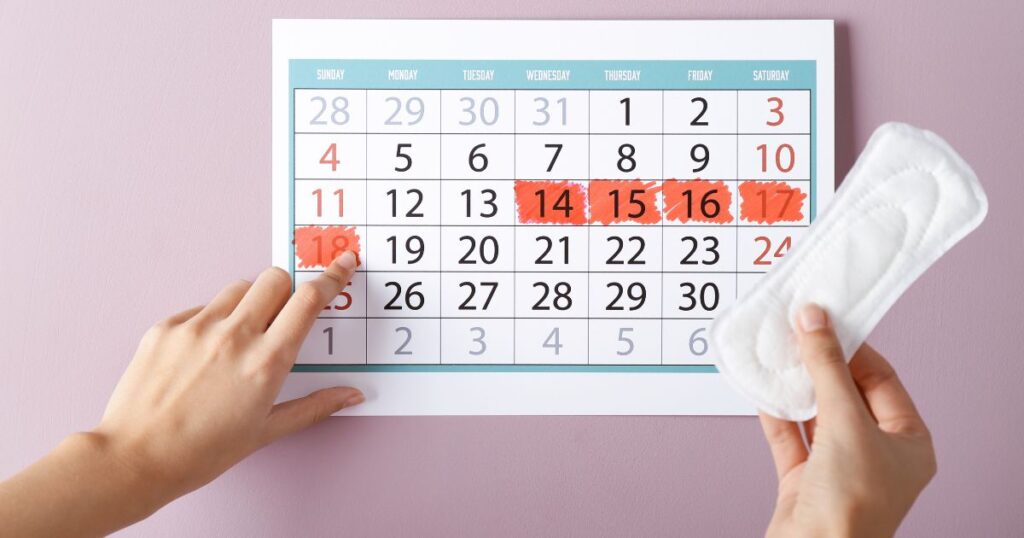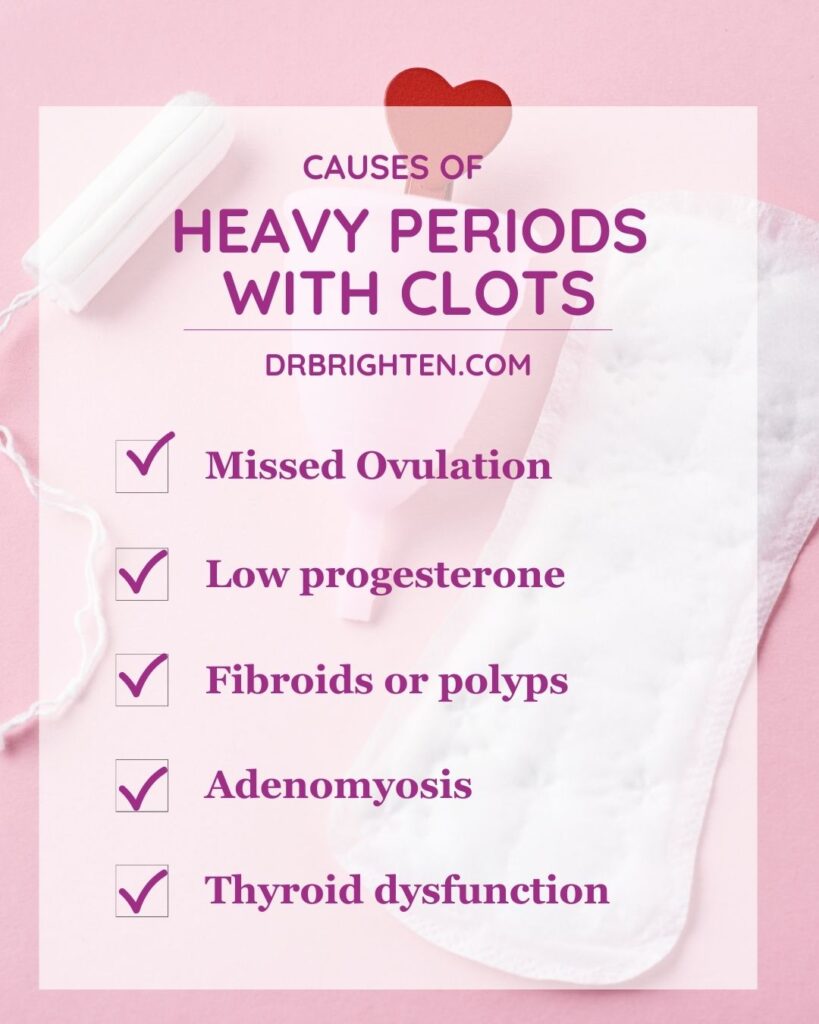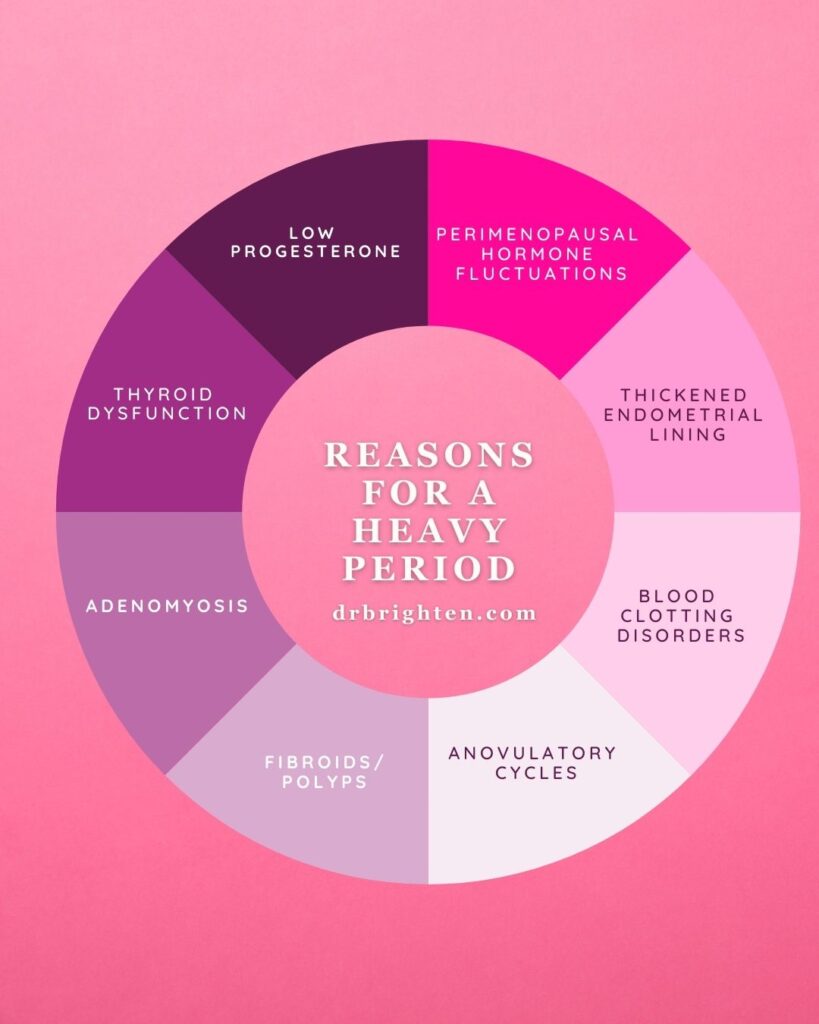Heavy periods in perimenopause are one of the most common (and frustrating) symptoms women face in their 40s and 50s. If you’ve noticed heavier bleeding, large clots, or sudden flooding during your period, you’re not alone.
Perimenopause is a time of major hormonal shifts, and for many women, one of the most noticeable (and disruptive) changes is to their periods1, including the length of their cycles and how heavy the bleeding is.
While some women in perimenopause start skipping cycles or spotting randomly, others find themselves dealing with the opposite issue: longer and more intense periods than ever before, sometimes including heavy periods with clots.
You might be asking yourself, Why are my periods so heavy all of a sudden? Or, is it normal to have big clots during my period at this age? These changes are common, although they might be uncomfortable. Below, I'll explain what you need to know about heavy periods in perimenopause, what causes them, and how to manage them naturally if they're causing you pain and other symptoms.
In this article:
- Quick Summary: Heavy Periods in Perimenopause
- Do Periods Get Heavier as You Get Older?
- What's Considered a “Heavy Period”?
- Normal vs. Heavy Periods in Perimenopause
- Why Heavy Periods Happen During Perimenopause: Hormonal Breakdown
- What About Big Clots and “Flooding” Episodes?
- Other Period Changes You Might Notice in Perimenopause
- How to Manage Heavy Periods in Perimenopause
- Frequently Asked Questions About Heavy Periods in Perimenopause
- Final Thoughts on Heavy Periods During Perimenopause
Quick Summary: Heavy Periods in Perimenopause
- Very common in women 40–54 (up to 78% report them).
- Caused by estrogen dominance, low progesterone, and anovulatory cycles.
- May include big clots, flooding, or long periods >7 days.
- Natural support: diet, DIM, magnesium, omega-3s, Vitex.
- Medical support: progesterone therapy, fibroid treatment, HRT, ablation.
Do Periods Get Heavier as You Get Older?
For some women, yes—periods get heavier with age.
Heavy periods in perimenopause are a common issue that women in their mid-to-late 40s and early 50s face, although some can start experiencing changes in their periods in their late 30s.
The average age of menopause (when periods stop completely for 12 months) is 51. But perimenopausal symptoms, including heavy menstrual bleeding or periods with clots, can start up to 8–10 years before menopause officially begins, such as in your early or mid-40s.
How common are heavy periods during perimenopause?
More than 3 out of 4 women2 (78%) between the ages of 40–54 report experiencing heavy menstrual bleeding within a six-month window, and 90% say they've had periods that have lasted more than 10 days.
Another large survey found that 91% of middle-aged women (over a three-year timeframe) experienced at least one episode of heavy bleeding3 lasting 3 or more days.
A large study4 tracking thousands of menstrual cycles (in women ages 42–52) found that many women experienced:
- Bleeding for 10 days or more on at least three occasions
- Spotting lasting six or more days
- Three or more days of heavy bleeding
Related: When Does Perimenopause Start and How Long Does It Last?

What's Considered a “Heavy Period”?
Heavy menstrual bleeding, also called menorrhagia, refers to periods that are unusually heavy or that last longer than normal. While “heavy” is subjective, it's more common than you might think: about 1 in 3 women describes their period as heavy5, and 1 in 20 seeks help from a healthcare provider for it each year.
From a clinical standpoint, heavy bleeding typically means losing more than 80 milliliters of blood per cycle (about ¾ of a cup or 2 shot glasses) or bleeding for longer than seven days.
You might be dealing with heavy bleeding if:
- You need to change pads or tampons every 1–2 hours
- You double up on protection (tampon + pad) to avoid leaks
- You pass blood clots larger than a quarter
- You frequently bleed through clothes or bedding
- Your period disrupts your sleep or daily activities
In severe cases, heavy perimenopausal bleeding may meet the criteria for menstrual hemorrhage, especially when flow is excessive enough to interfere with daily life.
Related: Is Heavy Menstrual Bleeding Making You Anemic? and Common Period Problems + 6 Natural Treatments
When to See a Doctor
See a healthcare provider if you:
- Bleed longer than 10 days
- Need to change pads/tampons hourly
- Pass clots larger than a quarter
- Experience dizziness, shortness of breath, or fatigue (possible anemia)
Normal vs. Heavy Periods in Perimenopause
| Feature | Normal Period | Heavy Period in Perimenopause |
| Cycle Length | 24–35 days, fairly predictable | Often shorter (21–24 days) or irregular (long gaps or skipped cycles) |
| Period Duration | 3–7 days | 7–10+ days; may alternate between light and very heavy |
| Blood Loss | ~30–40 mL (2–3 tbsp) | 80 mL or more per cycle (¾ cup / 2 shot glasses) |
| Clots | Small, occasional clots (< dime size) | Larger clots (quarter size or bigger), frequent “flooding” episodes |
| Pad/Tampon Changes | Every 3–4 hours | Every 1–2 hours; often requires doubling up protection |
| PMS Symptoms | Mild to moderate cramps, mood changes | More intense cramps, breast tenderness, mood swings, fatigue |
| Impact on Daily Life | Usually manageable | Often disruptive (sleep disturbance, missed activities, risk of anemia) |
Why Heavy Periods Happen During Perimenopause: Hormonal Breakdown
The primary reason for heavier periods during perimenopause is hormonal imbalance, especially involving estrogen and progesterone.
Estrogen levels often remain high (or fluctuate wildly) during early perimenopause, while progesterone levels steadily decline. This is because ovulation becomes less frequent or erratic, and progesterone is only produced after ovulation.
This creates a hormonal imbalance known as estrogen dominance, where there’s more estrogen relative to calming, balancing progesterone.
Without enough progesterone to counterbalance estrogen, the endometrial lining (the inner lining of the uterus) builds up more than usual6 during perimenopause. This can lead to heavier bleeding when it sheds, and sometimes heavy menstruation with large clots.
In other words, hormonal changes that take place during perimenopause can cause:
- “Flooding” periods that soak through pads or tampons quickly
- Longer periods (lasting more than 7 days)
- Heavy periods with large clots (especially when bleeding is fast and intense)
- Shorter cycles (closer together, like every 21–24 days instead of every 28 to 35 days, which is considered “normal”)
- Periods that return sooner than expected, and sometimes spotting between periods
- More intense PMS symptoms like cramps, breast tenderness, and mood swings
- Fatigue, which can be linked to blood loss7 and possibly anemia
Anovulatory Cycles In Perimenopause:
Anovulatory cycles, which is when you have a period but don’t ovulate, are also common in perimenopause and can potentially be a cause of heavier or lighter than usual periods.
In these cases, estrogen stimulates the uterine lining to grow, but without progesterone to signal it to shed in an orderly way, the result can be delayed, sudden, or heavy bleeding.
In one analysis8 of women between 42 and 52, 20% of all menstrual cycles fell into the anovulatory category. Short cycles (less than 21 days) and long cycles (more than 36 days) were both more likely to be anovulatory, with 44% of short cycles and 65% of long cycles showing no ovulation.
Periods that were very short (1–3 days) or very long (over 8 days) were also more likely to be linked to anovulation.

What About Big Clots and “Flooding” Episodes?
If you’ve ever stood up only to feel a sudden gush of blood, or noticed large clots in your period, you might be dealing with what’s sometimes called “flooding” during perimenopause. This can feel alarming, but it’s often part of the same estrogen-dominant pattern.
Clots are formed when blood pools and thickens9 before being expelled from the uterus. In perimenopause, this can happen because the uterine lining is thicker than usual, or because the uterus is contracting more strongly to shed that lining.
Some common triggers for heavy periods with clots include:
- Skipped ovulation, which leads to an extra-thick uterine lining
- Low progesterone, which normally thins the lining and reduces inflammation
- Fibroids or polyps, which can increase menstrual flow (heavy periods due to fibroids are a common concern for women over 40, especially during the hormone-fluctuating years of perimenopause)
- Thyroid dysfunction or other hormone-related issues that affect cycle regularity
- Adenomyosis, which is when endometrial-like cells are found in the muscle of the uterus
If you're seeing quarter-sized clots or larger, or needing to change your pad every hour or two for several hours, it’s a good idea to speak with a healthcare provider to rule out issues like fibroids, menstrual hemorrhage, or anemia from blood loss.

Other Period Changes You Might Notice in Perimenopause
No two women experience perimenopause in the same way. That said, most women will notice some types of changes to their periods during perimenopause10, whether it's the length, intensity, or the PMS symptoms they do or do not experience.
Here are some of the most common shifts in periods that happen during perimenopause:
- Cycles become shorter at first, then longer and more spaced out over time
- Bleeding becomes unpredictable, with spotting in between or skipped months
- PMS symptoms intensify, including mood swings, irritability, anxiety, and bloating
- Flow alternates, with one cycle being light and the next heavy
Why the unpredictability? Because ovulation becomes less consistent during perimenopause. This leads to cycles that are no longer governed by the usual, predictable hormonal rhythm. Overall, things get less “regular” and can change from cycle to cycle, and periods can be different from than they used to be.

How to Manage Heavy Periods in Perimenopause
If heavy or long periods are affecting your energy, sleep, mood, or quality of life, there are ways to help restore more hormonal balance, including both naturally or with medical support. Here are some key strategies that can often help:
1. Support Hormonal Balance
Restoring balance between estrogen and progesterone can make a big difference in your flow, cramps, and PMS symptoms.
- Eat a fiber-rich, anti-inflammatory diet to help eliminate excess estrogen
- Include cruciferous vegetables (like broccoli, kale, and cauliflower) in your meals to support estrogen detox with help from compounds like suforophane and fiber
- Consider supplements like DIM, calcium d-glucarate, or Vitex (chaste tree berry), found in my Balance Women's Hormone Support formula, which can help with hormonal metabolism and detoxification
- Talk to your doctor about bioidentical progesterone as a potential treatment for perimenopause symptoms if needed
Related:
15 Perimenopause Supplements for Happy Hormones
What’s the Best Supplement for Estrogen?
How to Balance Hormones Naturally
You can also check out my Period Problems Solution Protocol to help with all things period-related, including cramps, heavy bleeding, PMS, and other signs of hormonal imbalances.
2. Address Fibroids or Underlying Issues
If you’re experiencing heavy periods after 40 with clots or suspect fibroids might be involved, it’s worth exploring further with your doctor, particularly if you're in pain.
- Get an ultrasound to check for fibroids or polyps
- Ask about iron levels, especially if you’re feeling fatigued or dizzy
- Rule out thyroid dysfunction, which can worsen period problems
Related: What Are Fibroids & How to Treat Fibroids Naturally
3. Use Targeted Nutritional Support
Certain nutrients can help ease inflammation, balance hormones, and reduce blood loss.
- Magnesium (such as Magnesium Plus) can help support progesterone balance, relax uterine muscles, and help reduce PMS symptoms11
- Vitamin B6, zinc, and vitamin D (found in my Women's Twice Daily multivitamin) can manage the intensity of PMS symptoms12 and support mood
- Omega-3 fatty acids, such as Omega Plus, can help reduce inflammation and regulate the release of prostaglandins that cause cramps and heavy bleeding13
- Iron can prevent anemia from chronic blood loss

4. Support Detox Pathways
Your liver and gut help clear out excess hormones like estrogen, which can contribute to heavy bleeding if not processed efficiently.
- Stay hydrated and eat plenty of fiber
- Consider adding probiotics and liver-supportive herbs like milk thistle
- Avoid alcohol and processed foods that burden detox pathways
- Maintain a healthy BMI, since estrogen dominance is more common in women who are overweight or obese
- Exercise regularly to support overall hormonal health
5. Seek Professional Help if Needed
If natural approaches aren’t enough, talk to your doctor about:
- Low-dose hormonal birth control to regulate cycles
- Hormone replacement therapy (HRT) for broader symptom relief (though not first-line for bleeding)
- Endometrial ablation or other procedures for very heavy, persistent bleeding
Ready to Feel Clear, Energized, and in Control Again?
Download my free Perimenopause Weight Loss Action Plan, which is designed to help rebalance your hormones, boost your metabolism, and bring your energy and focus back online.
Inside, you’ll get a full 7-day meal plan, hormone-supportive recipes, a strength training guide, and tools to improve sleep, stress, and insulin sensitivity. This plan is tailored specifically for women in their 40s and beyond who are looking for help managing the perimenopause transition. Check out the Free Plan here and take the first step to feeling like yourself again.

Frequently Asked Questions About Heavy Periods in Perimenopause
Yes, heavy periods are very common during perimenopause, but they shouldn’t just be considered normal. Up to 78% of women between ages 40–54 report heavy menstrual bleeding. Hormonal shifts—especially fluctuating estrogen and declining progesterone—make bleeding heavier, longer, and sometimes irregular. While heavy periods in perimenopause are normal, very excessive bleeding may require medical evaluation.
Suddenly heavier periods in your 40s are often caused by hormonal imbalance. During early perimenopause, estrogen levels may spike while progesterone declines due to irregular ovulation. This imbalance causes the uterine lining to grow thicker, leading to flooding episodes, longer cycles, and heavy bleeding with clots.
Large clots during perimenopause usually occur because the uterine lining is thicker than usual or sheds all at once. This is often related to:
– Skipped ovulation (low progesterone)
– Estrogen dominance (lining builds up more than normal)
– Fibroids or polyps (which increase blood flow)
– Thyroid dysfunction or other hormone issues
Passing clots the size of a quarter or larger is a sign you should check with a healthcare provider.
Heavy bleeding in your 40s or 50s is often linked to perimenopause, but other conditions can cause it too. You should see a doctor if you:
– Bleed longer than 10 days
– Need to change pads/tampons every 1–2 hours
– Pass very large clots
– Feel dizzy, fatigued, or short of breath (possible anemia)
A provider can rule out fibroids, polyps, thyroid disease, or bleeding disorders.
Natural ways to reduce heavy bleeding in perimenopause include:
– Eating a fiber-rich, anti-inflammatory diet with cruciferous vegetables to support estrogen balance. You can grab a free recipe plan to help you get started here.
– Using targeted supplements like magnesium, Vitex, DIM, calcium d-glucarate (found in my Balance Women’s Hormone Support supplement) or omega-3s
– Supporting liver and gut detox with probiotics, hydration, and milk thistle
– Managing stress, sleep, and maintaining a healthy weight to support hormone balance
If natural methods aren’t enough, effective medical treatments for heavy bleeding include:
– Bioidentical progesterone therapy (Read more on when to take progesterone for perimenopause)
– Low-dose hormonal birth control (to regulate cycles)
– Hormone replacement therapy (HRT) for broader symptom support (Watch when and how to start hormone replacement therapy)
– Endometrial ablation or other procedures for very heavy bleeding
– Iron supplementation if anemia is present
Your treatment plan depends on whether heavy bleeding is due to hormones alone or conditions like fibroids.
Yes. Chronic heavy menstrual bleeding in perimenopause can lead to iron-deficiency anemia. Symptoms include fatigue, weakness, dizziness, and pale skin. If you suspect anemia, ask your doctor for a simple blood test and consider iron-rich foods or supplements alongside strategies to reduce bleeding.
Final Thoughts on Heavy Periods During Perimenopause
- Heavier periods during perimenopause can be inconvenient, as well as exhausting, painful, and even lead to anemia or other complications if left untreated.
- These hormone fluctuations can feel like a rollercoaster, especially between the ages of 45 to 52, when estrogen surges and progesterone plummets.
- If you're experiencing heavy menstrual flow in perimenopause, big clots during your period, or long periods with cramping and mood swings, remember that this phase of life is manageable with the right support.
- Try a combination of nutrition changes, herbs, lifestyle upgrades, and professional care if needed.
References
- https://pmc.ncbi.nlm.nih.gov/articles/PMC2666050/ ↩︎
- https://www.webmd.com/healthy-aging/heavy-bleeding-after-50 ↩︎
- https://news.umich.edu/prolonged-and-heavy-bleeding-during-menopause-is-common/ ↩︎
- https://pmc.ncbi.nlm.nih.gov/articles/PMC4199918/ ↩︎
- https://www.nhsinform.scot/healthy-living/womens-health/girls-and-young-women-puberty-to-around-25/periods-and-menstrual-health/heavy-periods/ ↩︎
- https://www.health.harvard.edu/womens-health/perimenopause-rocky-road-to-menopause ↩︎
- https://www.health.com/perimenopause-heavy-bleeding-fatigue-11699001?utm_source=chatgpt.com ↩︎
- https://pmc.ncbi.nlm.nih.gov/articles/PMC2666050/ ↩︎
- https://my.clevelandclinic.org/health/diseases/17734-menorrhagia-heavy-menstrual-bleeding ↩︎
- https://pmc.ncbi.nlm.nih.gov/articles/PMC4834516/ ↩︎
- https://pmc.ncbi.nlm.nih.gov/articles/PMC11013220/ ↩︎
- https://pmc.ncbi.nlm.nih.gov/articles/PMC10178419/ ↩︎
- https://pubmed.ncbi.nlm.nih.gov/22261128/ ↩︎

